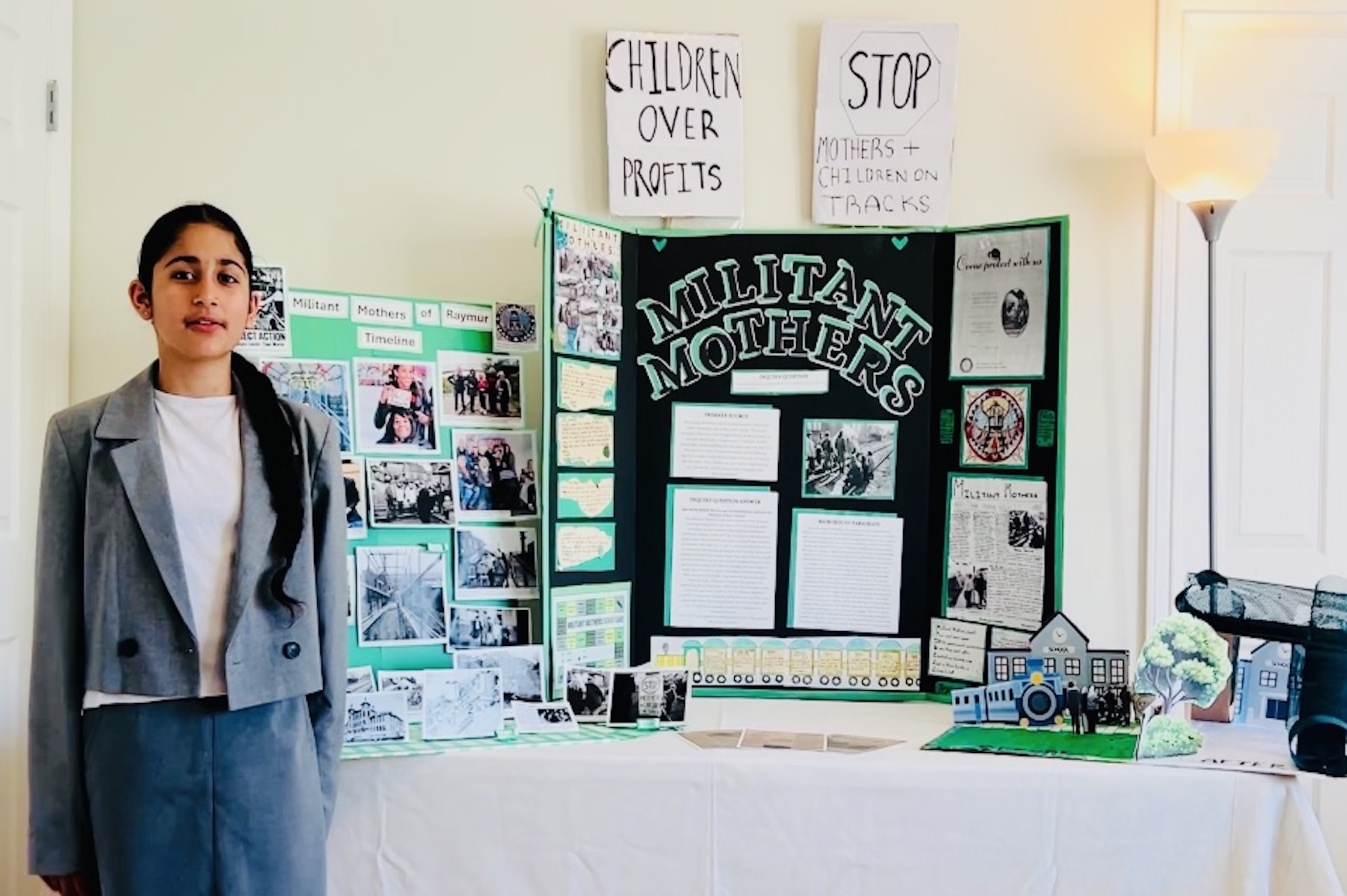Jasmine S.

Militant Mothers
Jasmine S.
From River to Sea Heritage Fair
Burnaby, BC
In 1971 at Keefer and Campbell Avenue, each school day, the kids from the Raymur housing project would have to cross the unregulated and unsupervised railway tracks to get to school, dodging trains and injury. That year, a group of mothers from Raymur asked Vancouver City Hall to build a pedestrian overpass to improve safety, but City Hall did not respond after months of letters, petitions, and calls.
The group started by asking the train companies - the CNR and BNR - to not use the tracks when children were in transit to and from school. However, the mothers predicted that these promises would be broken because the Raymur tenants were mostly poor and not a priority for the company - which happened after a few days. The group changed plans to make the railway companies listen. They set up camp on the railway tracks near Pender and Raymur, blocking train traffic. They had signs that read "Children vs. Profit" and "Petitions Don't Work" to raise awareness that the train companies were prioritizing train customers over the poor Raymur community. In response, the railways pursued legal action—but their efforts failed due to work by lawyer Bruce McColl, who volunteered his services to the mothers.
Faced with persistent and determined opposition, the railways eventually gave in. The mothers secured a legally binding agreement for the construction of the Keefer Street Rail Overpass, which opened in time for the new school year. It took months before the overpass was built and is still used today to safely cross. In 2019, the overpass was renamed the Militant Mothers of Raymur Overpass, and May 7, 2022, it was named Militant Mothers of Raymur Day to honour their legacy. The Militant Mothers civil disobedience campaign brought public support, giving them the confidence to legally fight for a pedestrian overpass.
What sources and evidence did you consult for your project? What different perspectives did they provide on your topic?
- Newspaper and Media Coverage: The campaign was widely reported in newspapers and on the radio, documenting their actions and demands.
- Museum and City Archives: Records of the protests, including photographs and documentation of the actions, are kept at the Museum of Vancouver and City of Vancouver archives.
- Community and School Markers: The RayCam Community Centre and Admiral Seymour Elementary School have murals and other markings celebrating the Militant Mothers Day
- Mosaic Tile: A mosaic tile on the corner of Campbell Avenue and Keefer Street honour their actions, according to The British Columbia Review.
- The Militant Mothers of Raymur Overpass: The pedestrian overpass was the result of their efforts and is a great achievement to their success, according to CBC.
- Documentaries and Videos: North Shore Women's Centre screened a documentary about the "Militant Mothers" in 2022, and videos of interviews with the mothers are available on platforms like YouTube.
- Artistic Representations: A linocut print by Joyce Woods and a musical by Theatre in the Raw, "The Raymur Mothers: They Wouldn't Take No For An Answer," further capture the story.
The perspectives that these sources provided a picture of the mother’s direct experience as well as the larger Canadian cultural perceptions of their struggle. The mothers experienced frustration with delays and dismissals from the city and rail companies, used direct action like setting up tents on the railway tracks to achieve their goal. Newspaper reporters considered their actions within an overall situation of class struggle, social revolution, and female empowerment. The city and rail companies viewed their actions as disruptions to train traffic and business operations, while the mothers saw their actions as justified and a necessary means to protect their children.
What is the historical significance of your topic?
The actions of the Militant Mothers of Raymur had a significant and lasting impact on Vancouver, leading to the construction of a pedestrian overpass, the establishment of the Ray-Cam Cooperative Centre, and the renaming of the Keefer Street Pedestrian Overpass to honor their efforts. They also inspired future generations to engage in activism and social justice.
Following is detailed breakdown of the impact:
- Construction of the Keefer Street Overpass: The mothers' persistent civil disobedience, including train blockades, forced the city and railways to deliver on a long-promised pedestrian overpass. This overpass, now officially named the Militant Mothers of Raymur Overpass, still stands and is being used by community members.
- Creation of the Ray-Cam Cooperative Centre: After securing the overpass, the mothers continued to advocate for community needs and established the Ray-Cam Cooperative Centre, a community center that provided childcare and recreational services. They also created a food cooperative for the residents of the Raymur housing project.
- Inspiration for Activism and Social Justice: The Militant Mothers of Raymur's story is often shared as an example of how ordinary people can effect change through collective action and determination. They have inspired individuals to engage in social activism and advocate for social justice. B.C. first poverty-reduction minister, Shane Simpson, who grew up in the Raymur Place housing project was inspired and he acknowledged that their victory in securing an overpass for safe school crossings helped shape his political career and his appreciation for social justice.
- Renaming the Overpass: In 2020, the City of Vancouver officially renamed the Keefer Street Pedestrian Overpass to honor the Militant Mothers of Raymur, recognizing their contribution to the community.
- Highlighting Widespread problems: Their actions raised awareness of the challenges faced by low-income families and the need for community investment in infrastructure and safety.
Why did you choose this topic?
I had learned a small portion of it in grade 4. I was really intrigued to learn more about this topic as it highlights the importance of standing up for marginalized communities and advocating for the well-being of children. The mothers of Raymur Place social housing complex, who occupied low-income housing in Vancouver, aimed to secure safe passage for their children. They argued that their children are the part of the society and deserve safety and care, regardless of their financial situation, class status, or neighborhood.
Their efforts were meant to ensure their children's safe travel, not to overthrow the rail lines or be revolutionary. In winning their cause they proved that one can fight at different levels of government (City Hall, The Canadian National Railway and Burlington Northern Railway- Crown companies).
The "Militant Mothers" became a symbol and a source of inspiration for future social justice campaigns and challenging those in power to bring about change in society and benefit the society for a good cause. The Militant Mothers of Raymur's story showcases the power of direct action, community organizing, and the importance of advocating for the needs of disadvantaged groups.

